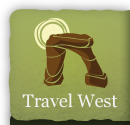Lake Powell Bullfrog
Bullfrog Marina is approximately 95 miles (153km) uplake from Glen Canyon Dam, with the Waterpocket Fold on one side and the Henry Mountains on the other. It offers the largest array of services of any of the uplake marinas.
What's In a Name?
Many people wonder where the bullfrogs are in Bullfrog. It is uncertain just exactly how Bullfrog got its name. In the days before the dam, there was a small rapids on the Colorado River at the mouth of Bullfrog Creek (now Bullfrog Bay). The rapids were named Bullfrog Rapids, probably after the creek. Older maps, however, show Bullfrog Creek on the east side of the river. The drainage that is now Bullfrog Bay was called Pine Alcove Creek on these maps. The most probable scenario was that Bullfrog was (mis)named for Bullfrog Creek.
Another story, probably apocryphal, is that Bullfrog was named for a rock formation found on Mount Elsworth, in the Henry Mountains just north of Bullfrog. Though there is no evidence to support this theory, you can see what appears to be a large frog stretched out on the west face of Mount Elsworth when driving south to Bullfrog on Highway 276. This formation is especially visible in the late afternoon sun.
Early Days
Like many of the places in Glen Canyon, the Bullfrog area has a history prior to Lake Powell and Glen Canyon Dam. One of the most fascinating stories recalls the efforts of Robert Brewster Stanton and the Hoskaninni Mining Company to wrest gold from the waters of the Colorado River.
There have been several attempts to take gold from the Colorado and San Juan rivers - none of them successful. Robert Brewster Stanton, a young engineer who had made survey trips down the Colorado, decided that a dredge was the key to success. In 1900 he formed the Hoskaninni Mining Company (named for a famous Navajo leader) and established Camp Stone (named after company president Julius F. Stone) in the Bullfrog drainage near the mouth of a creek which today bears his name.
The dredge was hauled, in pieces, from the railhead in Green River, Utah, across the Henry Mountains for over a hundred miles to the rim of Glen Canyon. A steep trail was blasted into Stanton Canyon (today Stanton Creek) and the dredge was hauled down and assembled at Camp Stone.
The dredge did not work as Stanton had hoped. He reported gold worth $30.15 in April and $36.80 in May - well short of an investment reportedly in excess of $100,000! The operation was soon abandoned after that and no attempt was made to salvage any of the equipment. It was reported that in 1938, former company president Julius Stone was on a river trip with some other companions and complained to them that he had never seen any return on his investment in Stanton's dredge. The group stopped at the dredge site and pulled out enough lumber to build a fire and boil a pot of coffee. According to reports, Stone drank a cup and told his friends, "This is the only return I ever had from the Hoskaninni investment. This cup of coffee cost me $5,000!"
The dredge, along with the other abandoned equipment, remained in mute testimony to the futility of trying to capture the fine "flour gold" of the Colorado until the 1960's. It now lies 335 feet (104m) under the waters of Lake Powell.
Bullfrog Today
Today, Bullfrog Marina offers the widest variety of services on the lake outside of Wahweap. There is a National Park Service visitor center which contains several exhibits relating the geological and human history of Glen Canyon. Books, maps, posters and videos about the area are for sale and personnel are on hand to answer questions. This center is open intermittently in March and 8 am - 5 pm daily from April through October. It's closed November through February.
This same building also houses National Park Service offices for the uplake District and Bullfrog Subdistrict. In addition, a medical clinic operates from this building from May through September. A physician's assistant staffs this facility and provides emergency medical care. NPS medics are on duty year-round. Emergency medical evacuation by helicopter and fixed wing aircraft is available.
The National Park Service also provides a launch ramp, portable toilet dump station, free boat pump-out station, picnic area, fish cleaning station, and paved landing strip for aircraft.
The concessioner, ARAMARK, provides a full complement of visitor services, including: a lodge, housekeeping units, food services, gift shop, grocery store, 2 campgrounds (one with hook-ups), laundry, showers, service station, boat rental, boat tours, and boat repair. There is a post office in Bullfrog.
The State of Utah maintains a regularly scheduled ferry, capable of carrying cars, trucks, rv's and trailers, which runs between Bullfrog and Halls Crossing. This is a fee service and is available on a first come, first served basis. The ferry is occasionally out of service for repairs. If ferry service is crucial to your trip, we recommend you call ahead to verify that it is in service. See a ferry schedule and price list.
Did you like this page? Did you find it helpful? Please consider sharing.
